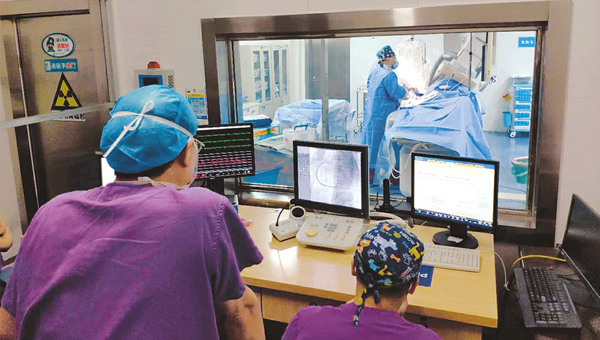Health care services optimized in Shanxi
Updated: 2022-09-15

Cardiovascular physicians examine a patient in a hospital in Shanxi province. [Photo/Shanxi Daily]
Shanxi province has comprehensively promoted the high-quality development of health care and achieved impressive results.
The average life expectancy in the province rose from 74.92 years in 2010 to 77.91 years in 2020, and major health indicators such as maternal mortality and infant mortality were lower than the national average.
Since 2012, the province has promulgated the "Healthy Shanxi 2030" Planning Outline and launched 16 special actions to change the focus from treating diseases to people's health.
The province has built 10 national-level healthy counties and districts and 23 provincial-level healthy counties and districts.
The prevention and control of major diseases has been carried out, and 14 national and 29 provincial-level comprehensive prevention and control demonstration areas for chronic diseases have been established.
The projects of early screening, diagnosis and treatment of cancer and cardiovascular and cerebrovascular diseases have benefited 681,500 people.
Shanxi has furthered the county-level comprehensive medical reform with the reform achievements of 117 county-level medical groups ranking among the highest in the country.
All 117 county-level medical groups have been connected to the resources of urban third-grade hospitals, specialist alliances, and telemedicine, making it more convenient for people to seek medical treatment.
Per capita financial subsidies and personal payment standards for medical insurance for urban and rural residents reached 610 yuan ($87.36) and 320 yuan, respectively.
A total of 82 kinds of medicines and 75 kinds of consumables have been purchased in the province through centralized procurement, with an average price drop of more than 50 percent, reducing related costs by nearly 4 billion yuan and reducing patients' medical burdens.
Free supplementation of folic acid services has benefited 5.21 million women, while free breast and cervical cancer checkups and free prenatal screening and diagnosis services have benefited 2.32 million rural women and 1.45 million pregnant women respectively.
For senior residents, 63.7 percent of second-grade general hospitals have established geriatrics departments and 2.99 million elderly people have received checkups free of charge.
Shanxi has carried out health personnel training projects and built 21 standardized training centers for national resident physicians and 10 pilot professional training centers of specialists, training 11,340 qualified resident doctors and more than 8,000 general practitioners.
The province has built 27 academician and postdoctoral workstations and introduced 30 academicians and experts.
The supply of medical and health resources has increased, and the number of practicing physicians per 1,000 population rose from 2.88 in 2012 to 3.26 in 2021, while the number of beds at medical institutions per 1,000 population rose from 5.22 to 6.57.
The coverage of traditional Chinese medical (TCM) services was also increased. There are eight 3A-grade TCM hospitals and 70 2A-grade TCM hospitals. There are 38 TCM demonstration cities and counties. All counties in the province completed the census of TCM resources to provide support for TCM industrial development.
In addition, the province has strengthened health education and health style promotion by conducting health awareness campaigns and carrying out health promotion campaigns in poverty-stricken areas.



